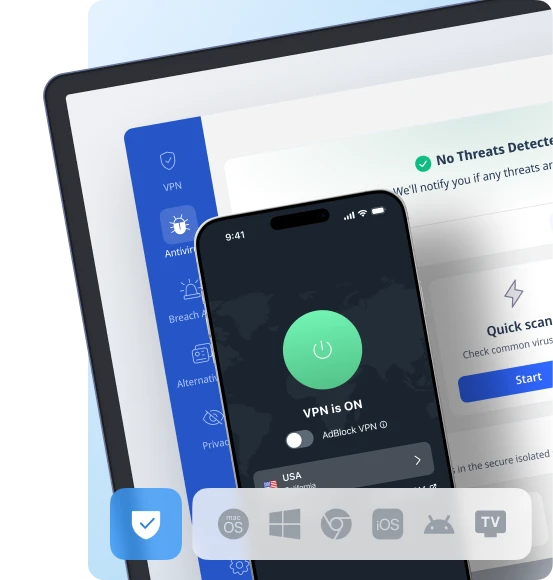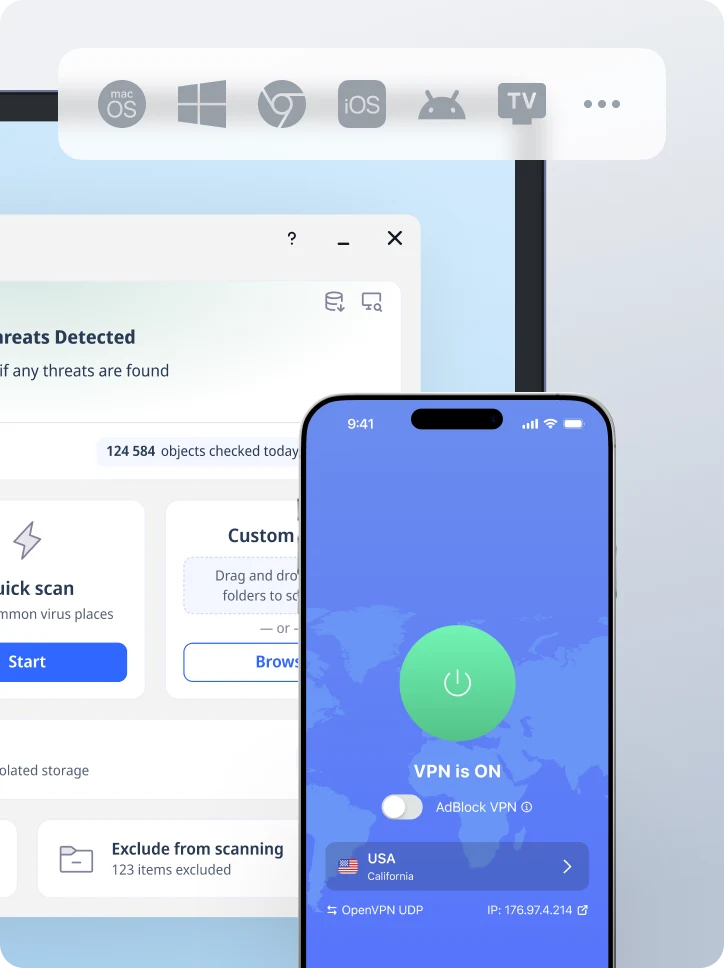Best VPN Settings: Dial in Speed, Privacy, and Peace of Mind
A virtual private network only works its magic when the switches are flipped the right way. Pick the wrong VPN server, forget a leak‑prevention toggle, and your Internet traffic might crawl or spill out unencrypted.
In this article, you’ll find the best VPN settings for everyday tasks like unblocking streaming services on Apple TV, dropping ping on gaming consoles, or sending email from an airport lounge. Plus things that may happen when the setup is sloppy.

Best VPN settings: key factors to tweak first
Here are the settings that worth enabling first of all:
Kill Switch
When the tunnel drops, a good switch slams every connection shut. TP‑Link laptop owners reported DNS exposure for up to twenty seconds when older firmware delayed the stop command. Flip the switch on day one and leaks never start.
Private DNS
Every domain you visit turns into a DNS query. If that lookup escapes the tunnel, your IP address and browsing habits sit in plain view for your ISP. Keep the “use VPN DNS only” box checked to seal the gap.
Obfuscated servers
Some campuses and certain countries block or throttle VPN traffic. Obfuscation re‑wraps packets to look like normal HTTPS so the filter lets them through. Turn it on when basic servers refuse to connect.
Split tunneling
Route low‑risk apps like Spotify or local news sites outside the tunnel, but keep banking apps and file transfers encrypted. You trim overhead and cut speed loss without opening yourself to snoops.
Double VPN
For sensitive research or whistle‑blowing, send traffic through two nodes in different regions. You stack two layers of encryption and break the link between entry and exit points.
Once these core defenses are locked in, the next gains come from device‑specific tweaks inside the VPN app.
VPN app tweaks across your devices
Other small adjustments inside the software keep the VPN feeling fast on every screen:
Auto‑connect on startup
Laptops and phones move between coffee shops, offices, and homes. Enable auto‑connect so no session begins unprotected. The toggle also covers mobile data when Wi‑Fi fades.
Protocol fallback rules
Choose WireGuard offers first for headline‑grabbing Internet speeds, then let the app drop to OpenVPN if a hotspot blocks UDP. Benchmarks in early 2025 clocked WireGuard around 900 Mbps on flagship routers after vendors patched driver bugs.
Per‑app exclusions
Some banks dislike shared IPs. Exclude their webpages so you avoid login hurdles while everything else flows through the secure pipe.
Advanced customization (desktop only)
On Linux and Windows, bind the VPN adapter to a fixed port and enable “block non‑VPN traffic” in the firewall panel. That rule kills sneaky background updates that try to bypass the tunnel.
Your choice of tunnel type matters as much as the software shell. Time to match jobs with the best VPN protocol.
Best VPN protocol for different tasks
These are the most prominent types:
Wireguard for everyday speed
Modern, lightweight, and peer‑reviewed, WireGuard pushes near‑gigabit rates on strong connections. Perfect for 4 K Netflix or large game downloads where VPNs reduce speed only slightly.
OpenVPN for legacy gear
If you own older routers or run rare *BSD builds, OpenVPN remains the compatibility champion. It uses AES‑256 by default, which most chipsets accelerate in hardware.
IKEv2/IPsec for mobile stamina
Phones drop signals while commuting. IKEv2 snaps sessions back to life quickly and saves battery, making it the go‑to for iOS hotspot hopping.
Stealth OpenVPN TCP for tough networks
Lock TCP to port 443 so packets blend with normal TLS. This trick bypasses deep packet inspection in libraries, dorms, and restrictive states.
The tweaks above work with many decent VPN service providers. But don’t be tempted by free VPN providers.
Why free VPNs are risky
Grabbing a free tunnel may sound like a good idea, yet a free option usually conceals a huge privacy cost.
They sell your data
Most free VPNs log browsing habits and device IDs, then pass them to ad brokers, the opposite of staying anonymous.
Outdated or weak encryption
Many freebies still use broken PPTP or L2TP, so the VPN encrypts nothing once attackers crack the tunnel.
Slow and overloaded servers
Limited bandwidth and overloaded nodes makes streaming or gameplay a buffering nightmare, and disconnects reveal your actual ip address.
In short, skip the hidden costs and stick with a reliable provider like VeePN instead.
Why VeePN’s smart settings make everyday use simple
VeePN bakes the adjustments above into clear switches so beginners stay safe and power VPN users stay flexible:
Automatic protocol picker
The app tests latency and packet loss, then chooses the quickest option—WireGuard, OpenVPN, or IKEv2—each time you hit Connect.
Dedicated profiles for streaming and gaming
Specialty servers bypass geoblocks on BBC iPlayer and keep ping low on worldwide game lobbies. You stream or frag without manual server hunting.
Deep device coverage
Install native VPN clients on Android, iOS, Linux, Windows, plus plug‑in browser VPNs for one‑tab isolation. VeePN even publishes router configs for whole‑home security.
AES‑256 encryption
Government‑grade ciphers scramble packets so packet sniffers see only gibberish. Whether you bank on hotel Wi‑Fi or join remote work calls, nobody peeks at your credentials.
2,500 servers in 89 locations
A sprawling network keeps hop distance short, which means higher Internet speeds and fewer lag spikes in competitive matches.
Strict No‑Logs policy
Headquartered in Panama, VeePN keeps zero activity or connection records. Even a court order finds nothing to hand over.
NetGuard ad, tracker, and malware blocker
Stops malicious domains before they load, slashing attack surface and speeding up page loads by trimming junk scripts.
Kill Switch and leak shields enabled by default
Private DNS, IPv6 block, and WebRTC filter close every common leak path. With VeePN, you stay invisible even if the hotspot glitches.
Split tunneling and app routing
Decide in one click which web traffic stays local and which travels the tunnel. Ideal for high‑bandwidth video calls that need local latency.
Double VPN and obfuscation options
Layer two encrypted connections (routes) or disguise packets as normal TLS to sidestep national firewalls and ISP throttling.
Try using VeePN without risks today, as we offer a 30-day money-back guarantee.
FAQ
Mix strong privacy features—Kill Switch, private DNS, AES‑256 encryption—with a speedy protocol like WireGuard. Keep servers close to cut latency and test for leaks after each tweak. Discover more details in this article.
Pick a low‑load server, enable split tunneling for non‑sensitive apps, set auto‑connect at boot, and run periodic DNS leak checks. Those steps squeeze performance while locking down every session. Discover more details in this article.
For most tasks, WireGuard tops the chart for speed and code transparency. Fall back to OpenVPN when networks block UDP or legacy hardware demands it.
- Install the VPN app like VeePN.
- Turn on private DNS and the Kill Switch.
- Select the nearest VPN server and choose WireGuard offers if available.
- Run a leak test, then save the profile so future logins reuse these hardened settings.
Discover more details in this article.
VeePN is freedom
Download VeePN Client for All Platforms
Enjoy a smooth VPN experience anywhere, anytime. No matter the device you have — phone or laptop, tablet or router — VeePN’s next-gen data protection and ultra-fast speeds will cover all of them.
Download for PC Download for Mac IOS and Android App
IOS and Android App
Want secure browsing while reading this?
See the difference for yourself - Try VeePN PRO for 3-days for $1, no risk, no pressure.
Start My $1 TrialThen VeePN PRO 1-year plan







